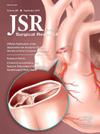Ground Level Fall, Who Do You Call? Appropriate Trauma for Ground-Level Falls on Anticoagulants
IF 1.7
3区 医学
Q2 SURGERY
引用次数: 0
Abstract
Introduction
While most trauma activations are based on mechanism or physiologic parameters, many centers incorporate specific risk factors (e.g., anticoagulant use) to upgrade lower-energy mechanisms. To address concerns about delays in diagnosing and treating traumatic intracranial hemorrhage in high-risk patients, our hospital revised its trauma activation criteria in December 2018. The update designated all anticoagulated patients with evidence of an injury above the clavicles as partial trauma team activation, ensuring an automatic response from the attending trauma surgeon and trauma surgery resident team. We hypothesized that early involvement of the trauma surgery team would be associated with a decrease in the time to critical intervention.
Methods
This is a single-center retrospective cohort study evaluating all ground-level falls on therapeutic anticoagulation or nonacetylsalicylic acid antiplatelet agents with evidence of an injury cephalad to the clavicles that were included in our institutional trauma registry from the beginning of 2014 to the end of 2019. The analysis examined injury incidence and the timeliness of interventions.
Results
Seventy-seven percent of the cohort had minor or no injuries and 38.4% were discharged from the emergency department. The most frequent nonminor injuries were intracranial hemorrhages (9.2%, n = 88), extremity fractures (10.9%, n = 104), and spine fractures (5.6%, n = 53). An emergent intervention was performed in 1.8% of patients (n = 17). After revising the activation criteria, time to computed tomography imaging decreased (average 76.4 ± 63.4 versus 36.8 ± 57.0 min, P < 0.0001); however, time from arrival to intervention for intracranial hemorrhage did not significantly decrease (average 281.5 ± 205.8 versus 230.7 ± 96.5 min, P = 0.36).
Conclusions
Given the low likelihood of urgent or emergent interventions that only a trauma surgeon can perform, trauma surgery team involvement in caring for this anticoagulated low-energy mechanism cohort may not represent an appropriate allocation of center resources. Rather than activating the trauma surgery team, a more selective approach is warranted to mitigate costs, decrease unnecessary charges, and optimize hospital resources. Emergency department protocols for expedited imaging and the rapid involvement of appropriate specialists may be more appropriate than a higher activation level.
地面坠落,你给谁打电话?抗凝剂对地面跌落的适当创伤
虽然大多数创伤激活是基于机制或生理参数,但许多中心纳入了特定的危险因素(例如,抗凝剂的使用)来升级低能量机制。为解决对高危患者外伤性颅内出血诊断和治疗延误的担忧,我院于2018年12月修订了创伤激活标准。该更新指定所有锁骨以上有损伤证据的抗凝患者为部分创伤小组激活,确保主治创伤外科医生和创伤外科住院医生团队的自动反应。我们假设创伤外科团队的早期介入与关键干预时间的减少有关。方法:这是一项单中心回顾性队列研究,评估2014年初至2019年底纳入我们机构创伤登记处的所有有锁骨头部损伤证据的地面治疗性抗凝或非乙酰水杨酸抗血小板药物。该分析检查了伤害发生率和干预措施的及时性。结果77%的患者轻伤或无伤,38.4%的患者从急诊科出院。最常见的非轻微损伤是颅内出血(9.2%,n = 88)、四肢骨折(10.9%,n = 104)和脊柱骨折(5.6%,n = 53)。1.8%的患者(n = 17)接受了紧急干预。修改激活标准后,ct成像时间缩短(平均76.4±63.4分钟比36.8±57.0分钟,P < 0.0001);然而,颅内出血患者从到达治疗中心到介入治疗的时间没有显著减少(平均281.5±205.8分钟vs 230.7±96.5分钟,P = 0.36)。鉴于只有创伤外科医生才能实施紧急干预的可能性很低,创伤外科团队参与治疗这一抗凝低能机制队列可能并不代表中心资源的适当分配。与其激活创伤外科团队,不如采取更有选择性的方法来降低成本,减少不必要的费用,并优化医院资源。急诊科的快速成像方案和适当专家的快速介入可能比更高的激活水平更合适。
本文章由计算机程序翻译,如有差异,请以英文原文为准。
求助全文
约1分钟内获得全文
求助全文
来源期刊
CiteScore
3.90
自引率
4.50%
发文量
627
审稿时长
138 days
期刊介绍:
The Journal of Surgical Research: Clinical and Laboratory Investigation publishes original articles concerned with clinical and laboratory investigations relevant to surgical practice and teaching. The journal emphasizes reports of clinical investigations or fundamental research bearing directly on surgical management that will be of general interest to a broad range of surgeons and surgical researchers. The articles presented need not have been the products of surgeons or of surgical laboratories.
The Journal of Surgical Research also features review articles and special articles relating to educational, research, or social issues of interest to the academic surgical community.

 求助内容:
求助内容: 应助结果提醒方式:
应助结果提醒方式:


